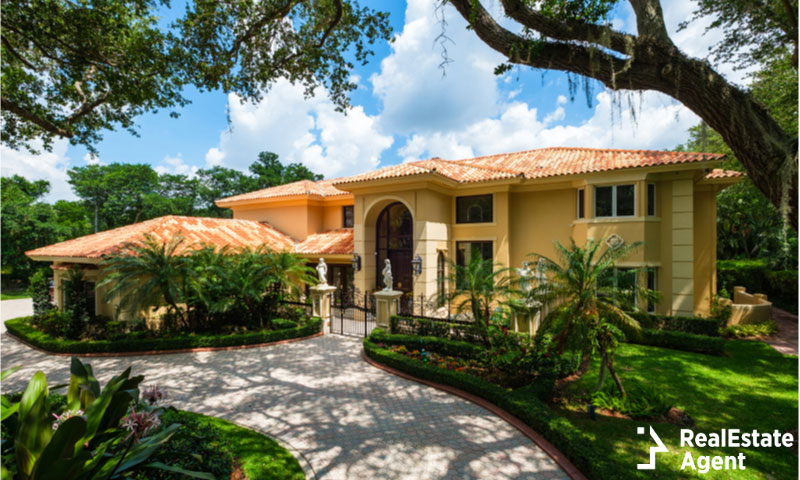Whether you’re looking into buying a home, building a house of your own, or just want to increase your vocabulary of real estate terms when it comes to home design, architectural styles are important. Houses don’t just get listed with a number of bedrooms and bathrooms. They almost always have a particular look and feel to them. These architectural styles can be cultural, regional, or just fashionable, depending on where you are and your price range.
The United States is a melting pot of culture, and the homes reflect that. No two houses are the same, especially when looking at the individual decor, but many homes share influences from classic designs. Here are just a few architectural styles that have become real estate trends in the past couple of decades and still crop up in the listings nowadays.
Mediterranean homes
Styled after the exotic houses of Spain and Italy that originated in the 1920s, these homes are statement pieces in their own way. Created as a result of the Roaring Twenties, when people enjoyed wealth and leisure, they brought the rise of waterfront resorts in the US. Mediterranean homes are most commonly found in California and Florida, where the weather is predominantly warm. With lengthy driveways, large patios, and lavish courtyards, they focus on the outdoors since they are the hearts of most family gatherings. They usually have plaster walls, carved doors, outdoor stonework, white painted brick or stucco, raw iron or metal work on windows, balconies or front doors, and red-tiled terracotta roofs. They evoke a sense of simplicity while classic elegance and wide-open spaces where the ocean breeze can work its wonders. With a Mediterranean home in California, you won’t need to worry about trends or updating the style. These are timeless and quintessential in luxurious neighborhoods across Cali.
The main Mediterranean home styles are:
- Italian Renaissance – marked by columns and round arches, it is inspired by the Italian Renaissance.
- Spanish Revival – with simple and clean lines inspired by Spanish colonial architecture, they often come with low-pitch roofs.
- Modern Mediterranean – this combination of Modern and Mediterranean characteristics comes with indoor-outdoor living space, as well as spacious and open floor plans.
Southern homes
This style is almost strictly regional since it doesn’t quite fit anywhere except the southern United States. Designed to handle the hot, humid atmosphere of places like Forsyth County, GA, New Orleans, Los Angeles, or Northern Florida, these homes put a focus on shade and usually include large shutters, porches, and overhangs. With hospitality exuding from every corner, the comfort and beauty of Southern homes are unmistakable. Southern homes showcase generational pieces through a classic and timeless design that can spark any conversation passed on from generations. The use of color and contrast is an art form, creating a space that transcends passing trends. Furniture pieces are long-lasting and will stand the test of time due to their resistance and resilience in the face of the latest fashion in interior design. Southern homes are designed in such a way that guest entertaining is possible in every room through a causal flow allowing every room to cohesively progress to the other with no harsh transitions.
Ranch-style homes
While this architectural style began on ranches, it has recently spread throughout the Midwest and throughout the country. Ranch-style doesn’t necessarily mean it is on an actual ranch. The term has come to mean any large, single-story home. With sprawling wings and long walkways, these homes are stylish and easily accessible for anyone. Inspired by the North American Spanish Colonial architecture, these homes are built to withstand the Southwestern heat with low roofs and wide eaves. From the 1920s, they became popular as ramblers, and by the 1950s, they became the most popular home style for Americans. Nowadays, ranch-style homes are no longer limited to one story as attic spaces are transformed into living spaces.
Modern homes
Modern homes are always eye-catching and unique, with clean lines, simple architecture, and a minimalist approach to detail. No two modern homes are the same since the style depends on the property instead of the actual home. With a focus on landscaping and vehicles, these homes usually come with roomy garages and well-groomed lawns. Given our modern lifestyles, many of these homes include a home office space that is designed in such a way to allow for productivity and little distractions. The minimalist movement is perfect for this.
These homes don’t have strict limitations regarding the outside-inside boundaries, using natural elements that surround the property to enhance the house’s functionality. They resulted from the opposition of overly ornate, fancy, and cluttered architecture predominant in the 19th century. The intentional asymmetry and openness visible both in the floor plan and the size of windows and doors wanted to break the traditional norms of residential architecture.
The emphasis on function was the architectural response to the fast-paced changes that were happening all over the world. When everything is moving fast, the need for simplicity comes from homes if it is unavailable elsewhere. Architecture gave the chaos-driven society a way to disentangle their lives and reconnect with natural elements. The psychology of light and color became a focus as cohesion was necessary to mix nature and modernist architecture.
Craftsman
Loft-like in nature, these houses look rustic and charming and usually boast expert woodwork and stone masonry in the architecture. The style arose in the 20th century as a reaction to industrialization in America, and people wanted individuality in their homes to avoid the mass-produced look of the surrounding neighborhoods. Inspiration came from the British Art and Crafts movements, also a result of Europe’s backlash to the Industrial Revolution. Craftsman architecture was the reaffirmation of the aesthetic beauty coming from natural materials and forms shaped by human hands. This rebellion against the status quo came first to California and the Midwest but soon spread across the nation. Size became a focus a century later, so most craftsman houses were medium-sized single-family homes that provided comfort and a homey interior coming from the wooden elements throughout the home, that felt suitable for family life.
Traditional homes
You may find these in charming, suburban neighborhoods, among many other houses that are alike in structure. With simple decorations and quaint details, these homes are picturesque and perfect in almost every way, especially from the front lawn. The basic construction makes them easy to repair and ultimately timeless. The hallmarks of the traditional home style are the clean and easy-to-recognize historical architecture that allows plenty of space for formal living and dining. Even nowadays, the rose-colored glasses through which we see the past singles this style out as the ultimate comfort from our childhood. These houses offer an increased amount of comfort that we long for in these hectic times when we spend more time in our homes surrounded by our families. A beautiful mix of old and new, these homes showcase revived furniture pieces, modernized color schemes, and the use of the old in our modern life.
Cottage-style
Like the ranch-style homes, this doesn’t necessarily mean the house is a cottage. Some of these houses are large and just utilize the charming box look of cottages. With attic rooms, window seats, and large front porches, these homes are reminiscent of the early 1920s. The reminder of charming fairy tales and countryside living is coupled with wide-open spaces and modern features most people expect from modern homes. Many people choose this style for second homes or vacation homes as they come with a quaint and charming aspect that inspires relaxation. Packed with character rather than multiple bedrooms, these homes are cozy, comfortable, and highly functional. Some of the characteristics of these homes are shingles, balconies, stucco walls, small porches, and bay windows.
Conclusion
Given the multiple options available throughout the country, it’s easy to see why America is seen as a melting pot by the rest of the world. Our homes are as different as the country’s population is but have the comfort and familiarity that makes anyone feel at home. From tiny treasures found at flea markets to historical artifacts that our ancestors left behind for us to cherish, these most common home styles across America carry our signature, our histories, and our heart. If the home style you like most isn’t common around where you live, you can build it. We own them, and they own us due to the memories they carry and the sense of family unity we embedded in them.Let us know in the comments below what style your home is. Contact the local real estate agents near the area of your interest if you’re looking to purchase a particular home style, and you’ll find yourself living your best life shortly. Like & Share this article with friends and family that love to learn more about their homes’ style choices and what brought them to be as prevalent throughout the history of our country.














